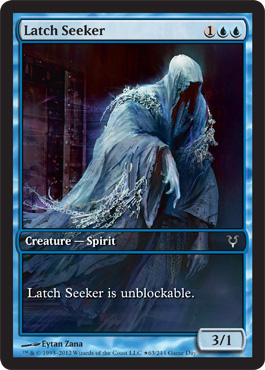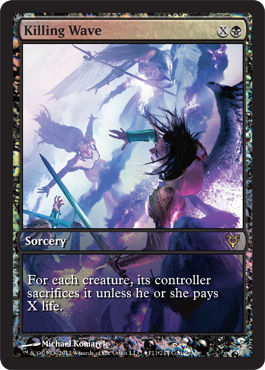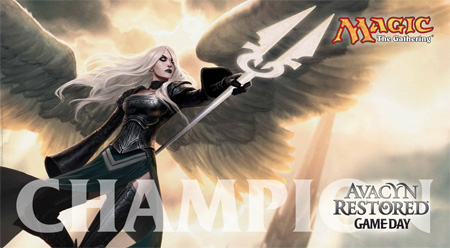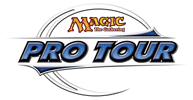You never expect it to be different.
It's just another tournament, you tell yourself. Sure,
there's more people – but not more than the M10 prerelease had two years ago at
Connecticon. Let's ignore that you weren't playing seriously back then. It's
still more or less the same situation.
You've got your deck, and you feel confident with it. You're
running on an undefeated streak against Delver – 7 wins and no losses in
competitive play against it. You've beaten just about every deck in the format
before – and there's no reason to believe that today is going to be any
different.
That's how I felt when I walked into the Convention Center
last Saturday morning. It was my first Pro Tour Qualifier, and while I didn't
have anticipation of winning, I thought that with good play and some reasonable
luck, I could certainly make Top 8.
I knew my deck. It was the same that it had been for a while
– Black/White Tokens. Still something that I loved playing. Base White aggro
decks are really my forte. The give and play that comes from them really plays
to my strengths, and I feel confident with the math. With a control deck, I
find myself contemplating the angles too much, but aggro is straightforward
enough that I know where my efforts need to be focused to avoid the tricky
plays. I can next-level myself by just playing a deck that fits me.
After walking in and registering, I catch up with Barret.
I'd met him at the SCG Invitational Qualifiers, held by Cyborg One. He used to
play Tokens, but has since switched to Wolf Run White. He's contemplating the
relative merits of Terminus vs Day of Judgment in the sideboard. Personally, I
think that Terminus is generally the better card – especially in a ramp shell,
but that's not really a discussion for right now – nor is it a subject I'm
terribly qualified to speak about.
I lend him a Wurmcoil Engine, and he gives me a stack of
prettily sleeved tokens because “If you're playing the deck, you might as well
have tokens that look good.”
Fine with me. Mike Noss, our local level 2, gets on the
microphone and announces that seatings are up, and everyone should take their
seat. Mike's a great guy, and he's currently mentoring me for Level 1 judge
status. Hopefully I'll be certified in a month or two, but we'll see.
Here’s what I register:
I sit down and pull out my playmat and deck. I start
shuffling, and the kid sitting across from me looks a little confused. I'm
polite, making small talk. Where are you from? Stuff like that. When I pull out
a pair of dice, things swerve.
“High roll sound alright to you?”
“...This isn't round one.”
“What?”
“Player's meeting.”
I've never been to a tournament with one of those. I laugh
and put the dice away, then politely wait to be informed about what's going to
be going on at this tournament, because apparently, I don't have the slightest
clue what I'm doing.
Don't worry kids, I'm trying to go Pro here.
Mike talks for a minute. There will be 8 rounds of Swiss,
making this the longest tournament that I've ever participated in by a single
round. A crowd of 187 players makes the room full, but not overly crowded.
First round pairings go up, and we're off to the races.
Round 1 – Sunny with UR Delver
Sunny seems like a nice guy, and he sits down with a smile.
He looks like he's been at events before, so we're pretty chatty before the
round. I shuffle and present, shuffling his deck. Usually, I'll just cut, but
since I'm told that a single cut isn't sufficient at higher level events, I'm
trying to build up the habit since I'll be attending some other larger events
in the near future. Some of you have seen my schedule – in my opinion, it's
sufficiently nuts.
A guy sitting two seats down presents his deck and smiles.
“May the odds be ever in your favor.”
I laughed at that. I love this community.
The match starts with him tossing down a Sulfur Falls –
tapped, which lets me breathe a sigh of relief. I'd kept a slower hand
involving three anthems and a pair of lingering souls. If he can't capitalize
on the early game, the late game should almost certainly fall to me.
That's pretty much how it goes after he plays a second
Sulfur Falls tapped on turn two, casting a Ponder and shuffling away the
results. This is not the ideal start for a tempo deck. Seeing that he doesn't
have a single viable threat on the board, I opt for playing out anthems early
and then casting a couple of Spirits, followed by a Hero of Bladehold to
quickly take game one.
As I’m shuffling for game two, a round a few seats over
calls a judge. Being a prospective judge, I listened in on the call a bit, and
frowned because I – sadly – knew the ruling. The active player had attacked
with Geist of St. Traft, and didn’t explicitly mention creating an angel. The
judge explained that he’d missed the trigger, although it’s mandatory, because
it creates a wholly beneficial action – creating a creature under your control.
The attacking player argued that he’d never heard that before, and that it had
always been assumed to make an angel when it attacked. Turns out, after
investigation, that it was his first Competitive REL event. My heart went out
to the kid, and the ruling cost him the game.
You never expect things to be different, until they are.
Game two starts off poorly, with me quickly dropping to 8
life, but a rather Timely set of Reinforcements balanced out my life total and
gave me enough board presence to crush the Delver deck's flimsy offense.
1-0 (2-0 in games)
Round 2 – Kyle with Esper Delver
I sit down for round two, already feeling good. It's strange
how a round one win can really light the fire under you. All of a sudden, it's
not a long eight round slog sitting before you – it's just five more wins, and
then you can double draw into the Top 8 slot. I felt great. Barret and a couple
of other people I knew all won their matches as well. Things were going great.
When I pulled my opening hand, seeing seven lands, I was
less than thrilled though. I mulligan, with my opponent snap keeping his. I
look at my hand and see a one-lander on the draw – worse, an Isolated Chapel.
The rest of the cards? Hero of Bladehold – no help there. A midnight haunting,
and three Champion of the Parish.
“Gonna keep?” Kyle asked.
“I don't know if this hand is insanely good, or absolutely
terrible.”
I topdeck a Gather the Townsfolk, a second hero, and then a
land. He's dead on turn 7, despite me never hitting my third land drop. I guess
that is a very keep-able hand.
The second game starts of poorly, with him flipping a pair
of Delvers and dropping me to five life. Fortunately for me, he misplays and
swings into a Midnight Haunting that he'd forgotten was there. (He knew about
it from a previous Gitaxian Probe that game, and just forgot to put two and two
together.) Thanks to Honor of the Pure, my spirit generator buys both of his
Delvers, and it's easy to regain life once Vault of the Archangel comes back
online. I gain 24 life, winning the game on 15.
I'm feeling on top of the world. Two matches into the PTQ
and I haven't dropped a game. I've not spotted any significant misplays on my
part, and my tokens are feeling as powerful as they ever have before. I've
crushed one of the best opening hands from the arguably best deck in the
format, and I only need to go 4-0 from here to make Top 8.
2-0 (4-0 in games)
Round 3 – Barrett Goss with Wolf Run White
I see the matchup and I shake my head.
“The randomizer hates me.”
I’m shuffling at the table when Barrett comes over. He’s
playing Wolf Run White or Naya Ramp, depending on his mood when you ask him.
The deck is a horrible matchup for me – mostly because he’s ramping to Elesh
Norn. It compounds the issues that I have with Wolf Run because once she hits
the field, it’s very rare for my creatures to survive in a fit state to close
out the game, and I have no non-creature source of reach.
He sits down and looks at me.
“Someone I know suggested that we could draw.”
“Would that help either of us?”
We talk it over for a bit. It wouldn’t hurt either of us,
but it certainly wouldn’t help much either. The matchup is certainly favoring
him, so I offer the draw.
He shakes his head. “Nah, we’ll just play it out.”
I shuffle my deck. I’ve beaten bad matchups before. This one
should be no different.
Racing against an inevitable Elesh Norn, I manage to take game
one by forcing him to cast Day of Judgment on turn 4 to avoid death by Hero of
Bladehold. I probably overextended into it a little bit, but it doesn’t end up
mattering. When he uses the board wipe, he kills his own Bird of Paradise, and
locks himself off of a second white source. Even though I stumble on threats
for a moment, I’m able to recover before he can cast Gideon, Elesh, or Terminus
– all sitting in his hand, uncastable.
Games two and three go similar to each other. I come out of
the gates slowly, and beat him for a few points before he gains a billion life
between Huntmasters, Timely Reinforcements, and Glimmerposts. I actually deal
him 20 in the second game, only to have him survive the game on 15. In the end,
it doesn’t matter because he’s able to Terminus to wipe the board and infect me
out with an Inkmoth/Wolf Run both times without issue.
2-1 (5-2 in games)
Losing to Barrett sucks, because I know he’s one of the
better players in the room. Beating him would have given me more confidence in
my ability to compete on this level, and while I don’t think he’s some
juggernaut, it’s certainly a bad matchup for me. Still, I’m a little down while
waiting for my next match.
Round 4 – Edgar Flores
with UR Delver
“Watch his hands. Also, he’s on UR Delver.” ~Barrett
For those of you who don’t know, Edgar Flores is a pro in
various CCG’s – YuGiOh, Magic, Pokemon, etc. He’s also been temporarily banned
at one point or another from all of them for cheating and theft. Barrett’s
advice was sound, but it ended up not mattering.
The idea of playing against a ‘pro’ was a little
intimidating, but I tried to remember that he’s on a deck that I have a good
matchup against. All I have to do is play reasonably, and I should be able to
take things.
I try chatting with him before the match, and he’s pretty
short and clipped with me. He’s clearly not here to have fun. I barely manage
to find out that he lost to Humans the previous round.
The short form of this matchup is that he got Stalker + 2
pikes in the first game, and my Oblivion Ring was too slow to save me. The
second game, he got Stalker + 1 pike, but I couldn’t find any artifact removal
in time and died to him Thought Scouring a ton of gas into the graveyard. I
didn’t get him below 10 in either match.
2-2 (5-4 in games)
Round 5 – Mark with
UW Delver
I sit down across from my opponent this round and laugh. It’s
the kid with the Geist of St. Traft ruling from before. Despite the round one
loss, he’s fought back to even. We talk for a bit – he’s a great guy, and he
lives near the World Cup Qualifier down in MD. I tell him that I’ll be there,
and hope to see him competing.
We also have a good laugh that I’ve gotten four delver players
in five rounds. At least it’s a good matchup, right?
The first game is pretty academic when he doesn’t play a
Delver first turn, and I get a Vault + any number of creatures into play. I end
the game on 25. I’d like to mention that I only lost one game the whole PTQ
where I ever had Vault and a creature simultaneously active. Those are some
pretty cool numbers.
The second game is a lot closer. He gets me to 2 life, but
can’t quite finish me off before I draw the fifth land and gain 9 life while
holding up a trio of vigilant 3/3’s. Vault of the Archangel, people. Tell your
friends.
3-2 (6-4 in games)
Round 6 – Josh with
(You Guessed It!) UW Delver!
The first game goes pretty much textbook – he gets an early
delver and uses it to beat me down to 3 life, while I assemble my doomsday
machine of creatures and anthems. At one point, he has a Geist of St. Traft,
and I’m being beaten down pretty hard.
“Swing with Geist.”
“Just Geist?”
“Yes.”
I look at my life total. I’m on 7, and I have a single
ground blocker. I bite my lip.
What do you do?
“I block here.”
“Take four from the angel?”
“…”
“…”
“Yea, take four from the angel.”
I’m not that guy – at least once we’re out of top 8
contention.
“Hey, just for the record, at Competitive REL, you need to
mention the Angel coming into play or you don’t get the trigger. Someone got
called on it before and lost the match because of it.”
“Oh shit, really?”
“Yea. I’ll take the four, but be careful about it. Some
people will call you on that.”
“Thanks man.”
I hit my fifth land, and start to lean on Vault heavily
while he’s gaining the same from a Sword of War and Peace. Unfortunately for
him, Vault gets more powerful as I get more creatures, and Sword gets weaker
when we both play spells. The game ends with me bouncing back up to 21.
Sometimes, things just aren’t that close.
Like the second game! He casts T1 Delver, flipping a mana
leak, then a T2 Delver, Delver. Both flip on turn 3, and I’m a little confused
when he doesn’t Leak my Midnight Haunting.
“Before blocks?” he says, dropping a pair of Vapor Snags on
the table.
“…that seems pretty good man.”
“First luck I’ve had all day,” he responds.
The third game is a long drawn out affair which heralds the only
time that Vault + creature didn’t win me the game. By the time it went active,
I only had one body in play, and despite being on 9 life, he was able to keep
my lifegain to a minimum by snagging tokens and finally closed out the game
with a late-game Delver that he blind flipped. I scooped it up and gave him a
smile.
“Guess you’ve got some luck after all. You’d better win out
now.”
“I’ll try to.”
“Triple delver, heh.”
“I’ll never see it again,” he agreed.
3-3 (7-6 in games)
Round 7 – Alvaro with
(Seeing a Trend Yet?) UW Delver!
I plop down into the seat. I’m getting a headache, and I’m a
little tired, but I told myself that I was playing all eight rounds. I’m hoping
to just play out these last two and call it a day. At 5-3, I’d probably be out
of the prizes, even if they are down to the top 32.
“Please don’t tell me you’re playing Delver.”
He looks guilty. Great. I wave nonchalantly.
“Sorry. I’m tired and I’ve gone against five Delver players
already. I’m getting pretty sick of the matchup.”
Linda, who’s sitting in the chair next to me, laughs. I
played against her in the Dark Ascension Prerelease in a win-and-in, beating
her for a top-8 berth. She’s pretty cool.
“Isn’t your matchup really good against Delver though?”
“It’s…pretty good,” I admit. My opponent doesn’t look happy.
My notes for these games include one word. “Vault.” Based on
the life totals, he was hitting me, then Vault went live, and despite him
swinging for 9 each turn, it wasn’t even close. The second game has him
mulligan to 5 and get stuck on two lands. His life went 20 – 10 – 1 - Game.
We were joking the whole time, and he smiled when he left. I
walked to give in match slips with Linda, joking about how we both did pretty
badly. A 4-3 record wasn’t exactly what either of us were hoping for when we showed
up. The two of us talk with the Level 2 Judge for a while – she’s borrowing her
deck from him.
The last round pairings go up and I mostly want to just get
it over with and go get dinner with my girlfriend.
4-3 (9-6 in games)
Round 8 – Linda with
RDW
Be careful what you wish for.
Neither match was close. She just absolutely steamrolled me
because I don’t have any answer to that many Stromkirk Nobles backed up with
burn and Lightning Maulers. She looks guilty about beating me the whole time,
but we keep joking about how it’s payback from the pre-release. I’ll have to
get her back for it next time we meet.
4-4 (9-8 in games)
Epilogue
Takeaways from this tournament were many and varied. The
field was a lot more homogenous than I expected. Delver was literally
everywhere, and while the matchup isn’t as invincible as I thought it was, I
still managed a 4-2 record against some stiff Delver players. I don’t know what
I can do to shore up the Wolf Run matchup, because it feels tough, but I’d like
to get some work done on it before the World Cup Qualifiers on the 16th.
PTQ’s are long, by the way. Eleven rounds, if you include
the Top 8. I’ve never gone past seven previously, and let me tell you, physical
conditioning isn’t as easy as it seems. I felt like a zombie for the next 24
hours. I’m going to need to make sure I start working on that so I can play my
best throughout the day – not just in the first three rounds.
I need to work on not tilting when I think I’m
disadvantaged. I need to keep looking for my outs, and keep looking for the
optimal line of play, rather than slipping into “Cast the biggest thing,” mode,
which I’m prone to doing when tired.
Most of all, I learned that while Magic is Magic, it’s also
got a different flavor in a competitive environment. It’s not a better or a
worse one, just different. That said, it doesn’t mean I need to be a douche
while playing. I’m going to continue to play my best – giving away nothing and
being a solid player, but I’ll make sure to have fun while doing it.
After all, I’m not exactly a Pro, yet.
-----
This weekend, I’ll be attending a TCGPlayer Diamond Event
for $5,000 in cash, plus a ton of various other prizes. It’s in Edison, NJ, and
starts pretty early. After that, I’ll be headed on up to New York for my
brother’s high school graduation. On Tuesday, you’ll get an article about
Deckbuilding, and what to look for when evaluating if a card is good enough for
a deck.
Next Thursday, we’ll have a tournament writeup for the Diamond event, so here’s hoping that I
did well.
As always, questions comments and ideas either here or on
reddit.
Thanks for reading,
-Andrew








